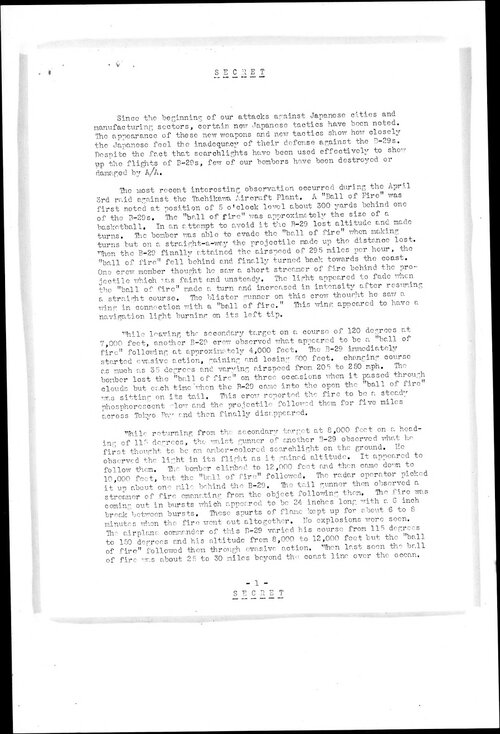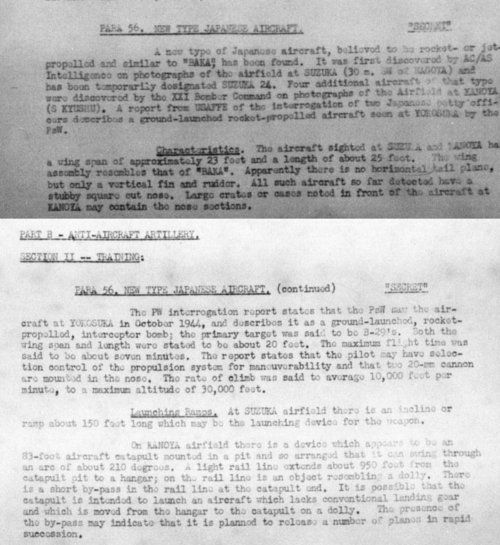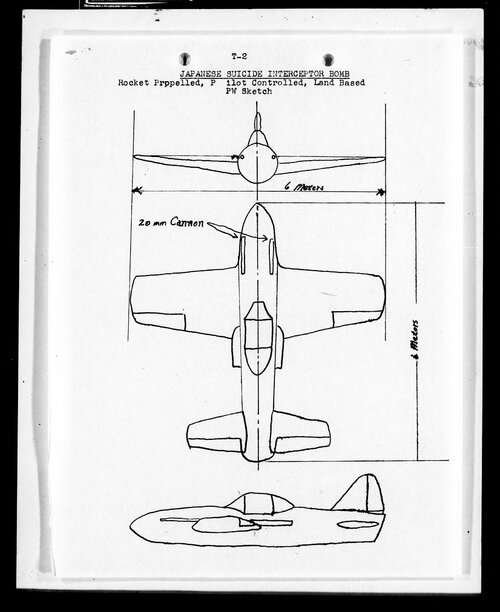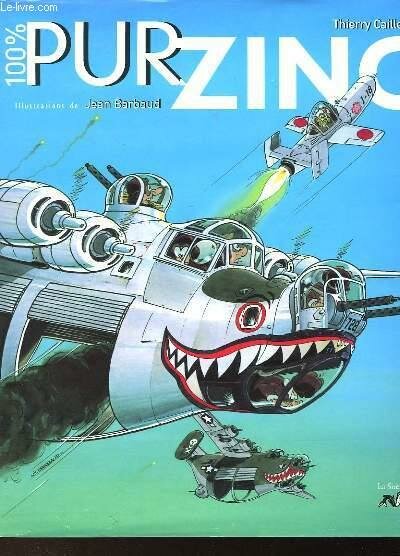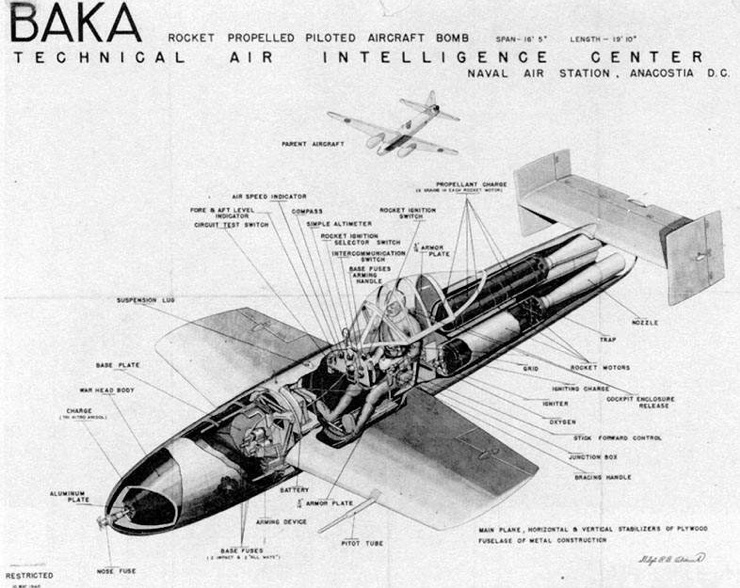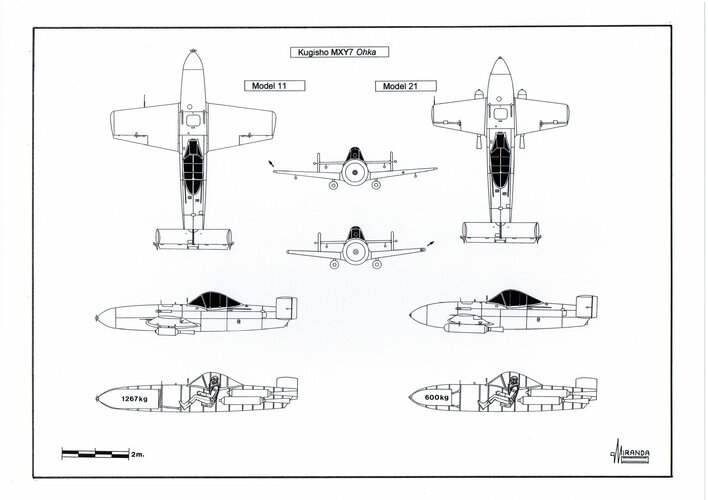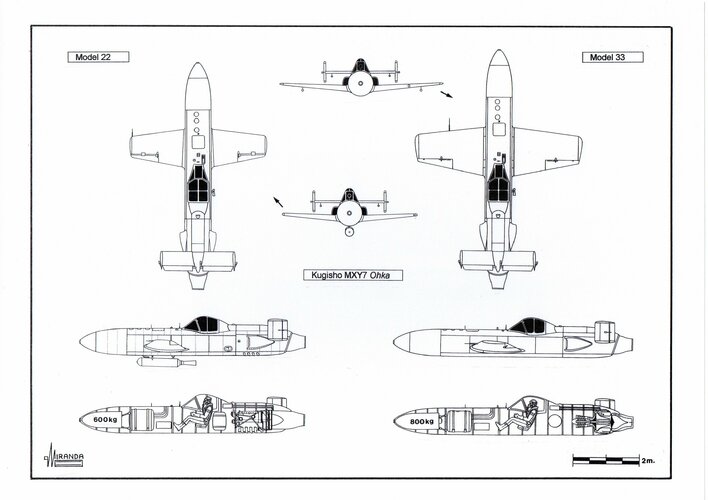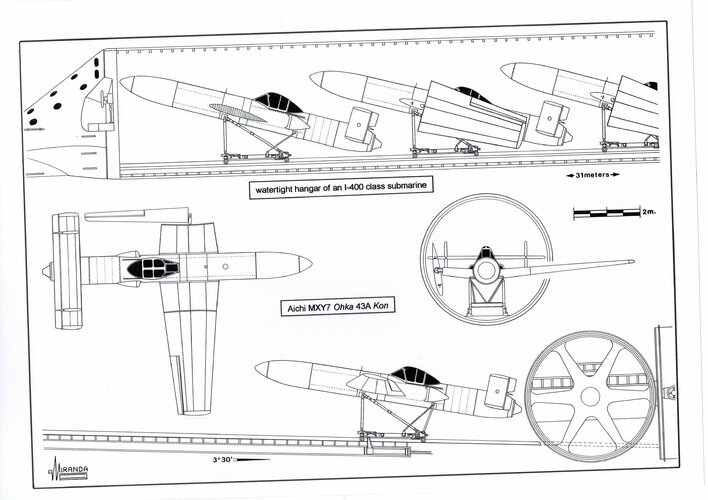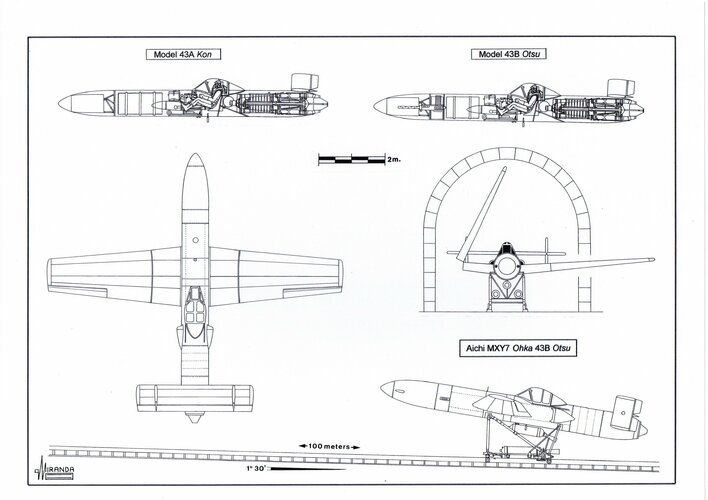The MXY7 Ohka Model 11was a small mid-wing monoplane with a fuselage of duralumin and wings and tailfins of wood. It has been designed by a transport pilot of the 405th Kokutai, Mitsuo Ohta, in August 1944. He inspired himself on the radio guided German bombs Hs 293 and Fritz-X that were launched from an aircraft flying almost on the vertical of the target.
The operational procedures established that the Ohka should be launched from between 16 and 37 km of distance to the target and at between 6,000 and 8,200 m of altitude. Following its flying profile, the Mitsubishi G4M2e Model 24J bombers that carried them were usually detected by the radars of the Allies from a distance of 130 km. Once detected, the fighters on CAP missions over the fleet could intercept the Bettys 111 km from the target. The powerful anti-aircraft defence deployed by the Allies warships in 1945 made almost impossible that a conventional bomber could fly with impunity over one of its Task Groups.
Previous to launch, the Betty initiated a shallow dive until reaching the take off speed of between 280 and 325 kph. The Ohka flight began as a shallow, unpowered dive, on a 5º 35’ gliding angle, reaching a cruise speed of between 370 and 450 kph. Some of the machines of the Model 11 last series carried a couple of Toku-Ro.1 Type 1 rockets under the wing roots that generated 300 kg of thrust during 10 seconds with the purpose of increasing its speed and range.
At a distance of between 3,000 and 8,000 m from the target, the pilot pressed the button on the top of the control stick to start the electric ignition of the three Toku-Ro.1 Type 2 rockets at the rear section of the fuselage. Each rocket had a length of 179 cm and a diameter of 25 cm, weighted 115 kg and contained 44 kg of solid fuel capable of generating 600 kg of thrust during 30 seconds. After the ignition, the pilot initiated the final 50º dive on the target reaching a terminal speed of 933 kph.
The Ohka could not be intercepted by the fighters at this stage and its course could only be altered by a direct impact from the heavy AA, due to the inertial momentum of the heavy warhead. Not even the pilot could alter its course as the pressure exercised by the air on the tail surfaces in transonic flight was superior to any muscular work applied to the flight controls.
The warhead had been designed for the destruction of major warships. It had a hardened steel warhead to pierce any armour deck and contained 512 kg of Trinitroanisol explosive. It had a length of 180.6 cm (without the nose priming plug) and a diameter of 60 cm and a weight of 1267 kg, including the three rear bolts. It had a wind air-armed fuse in the nosecone that automatically unblocked itself when the Ohka was released by the launch airplane. There were also four impact fuses at the rear of the warhead, activated by means of a T-handle located to the front right of the cockpit. The pilot carried a parachute for those cases when the bomb fell to the sea before reaching the target. The communication with the launch airplane was made by lights on the instrument panel and a one-way Gosport system of rubber tubing.
Trying to solve some of the operational shortcomings of the Ohka Model 11, the Model 21 was designed as a smaller version that could be carried by the fastest bomber available, the Yokosuka P1Y1 Ginga Model 11. The wingspan was reduced from 5.1 to 4.12 m. due to the smaller space available between the undercarriage legs of the Ginga. The warhead was also reduced to 600 kg. The Model 21 kept the three accelerator rockets of 30 seconds located at the rear section, while the 10 seconds rockets located under the wing roots were replaced by Type 3 rockets of 20 seconds. A one-third reduction in wing area meant that the handling characteristics of the Model 21 were far worse than those of the Model 11 and its range was inferior in spite of using five rockets. In July 1945, during the flight tests of the only prototype built, one of the rockets located under the wings did not ignite and the Ohka went completely out of control. The machine was destroyed and the pilot died.
It was decided to do without the rockets and replace them with the Tsu-11 thermo jet developed by the Kugisho engineers in 1944, based on the Italian technology on the Campini compressor. Originally designed to drive the Yokosuka MXY-9 Shuka, the school version of the rocket interceptor J8M1 Sushui, the Tsu-11 consisted of a conventional reciprocating engine, a single stage compressor wheel and a combustion chamber containing an annular fuel injection system and two igniters plugs that burned the air-fuel mixing creating a thrust of 250 kg.
The reciprocating engine was a 4-cylinder inverted, in line Hitachi Ha 11 Hatsukaze II of 105 hp (Japanese version of the German Hirth HM 504-A2). The Tsu-11 had a length of 220 cm, a diameter of 64 cm and a weight of 200 kg. At full throttle the reciprocating engine reached 3000 rpm and the compressor 9000 rpm. It was flight tested under the bomb bay of a Ginga by the end of 1944.
The version equipped with a Tsu-11 was named Ohka Model 22 and was built in a number of fifty units at the factories of Ichigisho, Aichi Kokuki, Fuji Hikoki, Miguro Hikoki and Murakami Hikoki, although only three of them were actually finished with the Tsu-11 for flying test. To transport the Ohka Model 22, a modified version of the Ginga P1Y3 Model 33 was designed following the model of the Junkers Ju 88 H-1 long range bomber. Its fuselage was enlarged 4 m and its wingspan increased to 22 m.
The operational procedure of the Model 22 established that the Ha 11 should be started by ground crews before take off, using the fuel provided by the Ginga during the flight, until launch. Compared to the system used in the Betty, the Ginga did not have enough room in its bomb-bay for the Ohka pilot to have access to it from the launch airplane. Therefore, he should stay within the Ohka at take off and communicate with the crew in the Ginga using a Gosport system.
Model 22 carried the same warhead of 600 kg than the previous design. A fuel tank of 225 litres was installed between the warhead and the main spar, another of 65 litres between the pilot seat and the engine and a third one of oil, of 10 litres, housed in a dorsal fairing behind the teardrop canopy. The new design had a range of 130 km that allowed the Ginga to reach safety before the fighters arrived. However, its cruise speed was just of 443 kph at full rpm, which made it an easy prey for the Hellcats and Corsairs that surpassed 600 kph. To accelerate during the final plunge, a Toku-Ro.1 Type 3 single rocket with 600 kg of thrust peak during 20 seconds, was suspended under the fuselage, equipped with front and rear cowling to reduce the air drag of the underpowered airplane. The rocket could be detached by a T-handle located on the floor in front of the pilot. Handling at high speed was improved by replacing the control cables from the Model 11 by a system of traction-resistant articulated bars.
To amend the low speed issue of the Model 22, the Tsu-11 was replaced by a Ne-12 B turbojet with a four stage compressor that had been originally developed by Ichigisho to propel the new jet fighter Nakajima J8N1 Kikka. The Ne-12B was a variant of the
Ne-12, a centrifugal turbojet based on the German designs Heinkel-Hirth HeS 8 and HeS 8a , that was lighted up to 350 kg. It had 180 cm of length and a diameter of 74 cm producing 319 kg of thrust at 15,000 rpm.
When the technical information on the more powerful BMW 003 A axial turbojet, with a smaller diameter than the Ne-12 B, was received from Germany by mid July 1944, it was decided to improve its performance. This was actually made by increasing the compressor stages, to reduce the rpm, and adopting a combustion chamber of smaller diameter, similar to the one in the BMW 003A. The new design was named Ne-20, measured 275 cm of length and 62 cm of diameter, weighted 450 kg and produced 475-500 kp of thrust. Its mass production was decided as power plant for the Kikka.
Most of the 40 units of Ne-12 B that have already been built could then be assigned to propel the new series of Ohka designated as Model 33. This model had the same wings and tail surfaces than Model 11, although a little longer fuselage and a warhead of either 800 kg containing 315.2 kg of TNT+PETN or of 900 kg containing 415 kg of RDX explosive. It measured 133 cm of length (without the nose priming plug) and 55 cm. of diameter. The Ohka Model 33 carried one single fuel tank of 250 litres located between the warhead and the main spar. It had a range of 213 km, much wider than the Model 22, and a speed of 643 kph, a little faster than the Hellcat and equivalent to the Corsair speed. The launch airplane should have been the four engine bomber Nakajima G8N1 Renzan that could carry an Ohka suspended under the bomb bay in long range missions or two Ohkas suspended under the wings in medium range missions.
There was a plan to convert part of the production of the Ohka Model 11 to the Model 33 by the end of the war. Considering the limited number of available Ne-12 B engines and Renzan airplanes, the mass production would have not been above thirty units. The Model 33 did not use auxiliary rockets. The possibility of having some of the new Ne-20 turbojet engines by mid 1945, to drive missiles and Tokko airplanes, led the Aichi Kokuki engineers to design the Ohka 43 series. However, the nearly 3 m of length of the engine forced them to adopt a longer fuselage and the lack of the right launch airplanes and the new power of 500 kp available with the Ne-20, advised the creation of an airplane able to take off by itself, fitted with wooden wings and tail planes of a considerable size. The wingspan was widened from 5 to 8.972 m affecting the maximum speed that decreased to values below 600 kph and therefore left it exposed to interception.
The proposal was to build two variants designated Ohka 43-Ko and Ohka 43-Otsu at the Aichi-Gifu and Aichi-Oyaki factories. The first one was a replacement of the Aichi M6A1 Seiran that would be carried and launched from the new Sen Toku submarines of the I-400 series. Its watertight deck hangar had 31 m of length and 3.5 m of diameter and could house either four Ohkas or three Seirans or two Saiuns or four Baikas.
The Ohka, with backward foldable wings, moved over rails along the hangar, fixed to launching cars of 700 kg that could adjust their height and slope to several types of airplanes. With the submarine on the surface, the launch sequence was made with the help of two teams of four and six men respectively and went through a defined procedure. First, manual unblock and opening of the hangar door by means of an hydraulic mechanism; then, connection of the hangar rails with those in the launch ramp using two detachable rails. The Ohka was then pulled over its launch cart up to the start of the ramp (of 24 m of length and 3º 30' of slope) and the whole combination was fixed to the hook of the submarine steam catapult. The hangar door was then closed and secured, the wings unfolded and blocked and starter of the Ne-20 connected to an external wall socket. The Ne-20 was then started and the wall socket disconnected. The pilot gets in the cockpit and tests the telephonic connection with the bridge, the control surfaces, the throttle and the compass. The submarine now sails facing the wind at its maximum speed of 18.7 km and the pilot selects ‘full throttle’ at 11,000 rpm. The crew takes refuge in the conning tower before the catapult is fired, the Ohka takes off and the cart falls to the sea.
In case of individual missions the submarine dives to reach a new launch position. For multiple launches, the well trained crew may launch the four Ohkas in 12-15 minutes. The pilots were equipped with parachutes but did not need radio equipment or oxygen to fulfil their mission. Their assignments might be either to attack the Allies fleets located in Ulithi and Pearl Harbour or vital centres located in the west coast of USA, or to destroy the Gatun and Miraflores floodgates of the Panama Canal, the task for which the Seiran had been designed.
The Ohka 43-Ko carried the same warhead (version of 800 kg) than the Ohka Model 33 but without the nose priming plug. Its fuel tank capacity was of 400 litres and it was located between the warhead and the main spar. The oil tank of 16 litres was between the pilot seat and the turbojet. It could reach targets placed 278 km from the launch point.
The ‘Ko’ version did not use auxiliary dive rockets. It released the folding wingtips by means of electrically activated explosive bolts, during the terminal dive to increase its speed. It was expected that it could surpass the 900 kph when reducing its wingspan to just 2.6 m. At this stage control was obtained by using the tail surfaces that could move in differential mode to act as ailerons. In normal configuration, the Model 43 had 13 sqm of wing surface, 4º 30' of dihedral angle and 2º 30' of tail plane incidence.
The ‘Otsu’ version was designed to take off from a 110 m length straight railway section and hide in the railway tunnels with its wings folded. Developed to avoid the use of conventional aerodromes in a situation of complete aerial superiority of the enemy, it was inspired by the launch procedure of the Messerschmitt P.1079 (July 3, 1942). The idea was to use it in a long range coastal artillery role to counteract the invasion of southern Kyushu, or ‘Olympic Operation’, which was expected to happen on November 1, 1945.
The Model 43-Otsu used a launch cart for take off similar to one used by the naval version but propelled by two Toku-Ro.1 Type 2 rocket engines with 600 kg thrust each and 30 seconds of life and by the power of its own Ne-20 turbojet. At the end of its run the cart was detached and braked by a cable and a counterweight system. At that moment, a third Toku-Ro.1 Type 3 rocket with 600 kg peak thrust and 20 seconds endurance automatically ignited. This was fixed to the fuselage centreline and its nozzle had an 8º 45' slope to make the thrust axis and the gravity centres of the Ohka converge, thus providing maximum lift.
The land version used the same warhead than the naval one but it was armed with two Type 3 machine guns of 13 mm with a rate of fire of 800 rpm located between the warhead and the fuel tank, which capacity had been reduced to 300 lt, and a combat range to 200 km. The guns configuration was inspired by the German air to air rocket bomber Sombold So 344 project and its objective was that the Ohka could break its way towards the Allies Task Forces fighting against the defensive fighters to which it was equal in speed. The ‘Otsu’ kept the mechanism to detach the wingtips of the naval version but was not considered a requirement to equip it with accelerator rockets for the terminal dive. It was expected that it would be able to surpass the 900 kph in a 50º dive with the Ne-20 at full throttle.
All the combat versions of the Ohka were protected from the rear against 12.7 mm ammunition of the Browning M2 machine guns used by the U.S. NAVY interceptors. The pilot seat was armoured and 15 mm steel plates were installed behind his head and shoulders and in the cabin floor under his legs. Frontal armour was considered impossible as the state of technology at the time could not produce armoured glass able to stop the 40 mm projectiles of the naval AA.
Two version of training were built to make the pilots familiar with the Ohka weapons system. The K-1 was an unpowered aircraft with landing skid and warhead replaced by water ballast. It was then succeeded by its refined version K-1-KAI Wakarazuka, derived from the Ohka 43. It was a two seat airplane with double flying controls and one Type 4 Mk I Model 10 rocket for ignition testing. A training rocket catapult with a 100 m long ramp was built in Takeyama, to the west of Yokohama, over a hill of 600 m of altitude located 3,000 m from the airfield where the Ohka gliders should land. Forty five Ohka K-1 and two K-1-KAI were manufactured before Japan surrendered to the Allies.
The Ohka Model 11 that took part in the first combats was overall painted in bright blue. Afterwards a paint scheme was adopted with pale green upper surfaces and pale grey under surfaces. The known units of the Model 22 were overall light grey. The training version units were painted in bright orange at the manufacturing plant, then receiving a dark green coating in the upper surfaces only. In all piloted versions the cockpit interior was factory applied dark green.
Technical Data Model 11 (Model 21) ((Model 22))
Wingspan 5.1 m (4.12 m) ((4.12 m))
Length 6.07 m (5.62m) ((6.88m))
Height 1.16 m (1.16 m) ((1.15 m))
Wing area 6 sqm (4 sqm) ((4 sqm))
Max weight 2140 Kg ((1450 kg))
Max Speed 648 Kph ((443 kph))
Max diving speed 926 kph
Warhead 1267 kg (600 kg) ((600 kg))
Fuel ((290 litres))
Oil ((10 litres))
Range 36 km ((130 km))
Engine 3 rockets (5 rockets) ((one TSu-11))
Launch G4M2e (P1Y1) ((P1Y3))
Technical Data - Model 33 (Model 43A) ((Model 43B))
Wingspan 5m (8.97m) ((8.97m))
Length 7.2 m (8.16 m) ((8.16 m))
Height 1.15 m (1.3) ((1.3))
Wing area 6 sq.m (13 sq.m) ((13 sq.m))
Max weight 2120 kg (2270 kg) ((2260kg))
Max speed 643 kph (596 kph) ((596 kph))
Warhead 900 kg (800 kg) ((790Kg))
Fuel 250 litres (400 litres) ((300 litres))
Oil 10 litres (16 litres) ((16 litres))
Range 213 km (278 km) ((200 km))
Engine one Ne-12B (one Ne-20) ((one Ne-20))
Launch G8N1 (Submarine I-400 Class) ((Railway))

